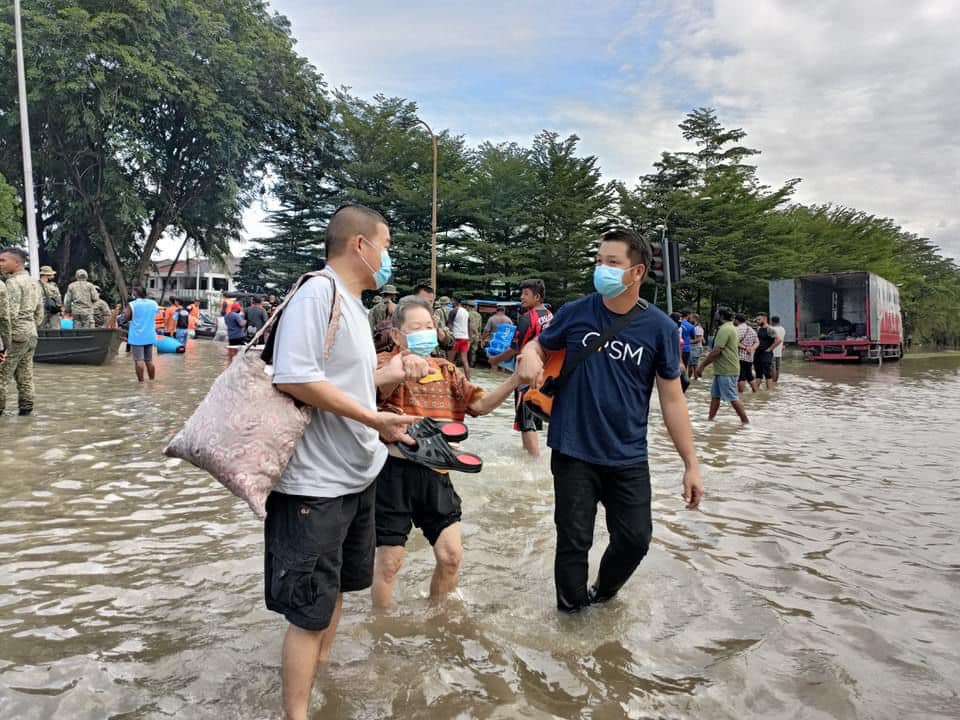2021 ended with a splash. Weeks ago, a freakish rainstorm caused devastating floodings across eight states in Malaysia, leaving areas submerged for days and costing the nation RM1.4 billion in infrastructure damage.
Homes were destroyed, roads and highways cut off, and businesses suffered insurmountable losses. Unofficial accounts predicted economic losses could amount to an eye-watering RM20 billion.
On December 18, the heavy downpour in Kuala Lumpur exceeded a month’s worth of rainfall in just 24 hours. It was one of the deadliest disasters to hit the country since the tragedy of 1971. At least 54 lives were lost, and 125,000 people were displaced. Heartbreaking.
Without electricity, flood victims were cut off from the outside world. Then, as hunger and thirst set in, and desperation pushed them to their limits.
Many were trapped in their own homes by high waters with barely any food; their power and water supply were also disrupted. Without electricity, flood victims were cut off from the outside world. Then, as hunger and thirst set in, and desperation pushed them to their limits. They screamed at rescue boats for food and essentials. People broke into and looted grocery stores out of hunger.
Multiple news reports and victim accounts confirmed that civilian rescuers dominated earlier rescue and relief efforts. Through social media, volunteers coordinated their best by blasting SOS alerts, connecting rescuers to victims, kickstarting donation drives and documenting stories on the ground. The mobilisation of personnel and assets by government agencies like the National Disaster Management Agency (NADMA) and Selangor Disaster Management Unit (SDMU) felt scattered and lethargic in comparison.
Prime Minister Dato’ Sri Ismail Sabri admitted to the weaknesses in flood management and promised improvements, and stressed that he would not defend the shortcomings of NADMA in activating and coordinating related agencies to face the crisis.
In the following days, the Yang di-Pertuan Agong called for a post-mortem on the crisis and proposed additional drainage to reduce incidents of flash floods in the future. Political leaders from across the political spectrum were quick to echo the Agong and urged Ismail Sabri’s cabinet to hold a special meeting to provide a full explanation and debate on the best measures to expedite the activation of crisis relief assets.
In January 2022, Ismail Sabri called for a special Parliamentary sitting on January 20. “It is to discuss matters relating to national interests which is the flood and post-flood assistance coordination for the Malaysian Family and the long-term flood management plans,” he declared.
People are sick of the finger-pointing behaviours of top leadership that not only resolved nothing, but ultimately caused more delays in implementation. It is invigorating to finally see one person willingly step up and take accountability.
In anticipation of the sitting, below are seven important questions that we want to see answered:
1. What was NADMA’s role and what actions were taken when floodwaters were rising in parts of Selangor on 18 December 2021? What instructions were given to the state disaster management committees or state governments?
2. In preparation for the monsoon season and heavy rainfall, did NADMA or other agencies put on stand-by sufficient boats, helicopters, and other assets in anticipation of possible floods?
3. Malaysians with boats and heavy vehicles were ready to assist evacuation efforts. Did any government agency coordinate or take the lead in managing the deployment of private assets to help in rescue and relief on the ground?
4. When were the evacuation orders given to residents of Shah Alam and Hulu Langat? And for other areas subsequently affected by the floods?
5. Waters from two dams were released into Hulu Langat area, which contributed to the devastating flood and damages in the area.
a) Which agency is responsible for monitoring and managing water levels at all the dams?
b) When were “critical levels” at the dams detected, and what warning was given to the relevant local authorities?
c) Is there an SOP for coordination between agencies when water from dams is released? Was that SOP followed in the lead up to the December 2021 floods?
6. How much was budgeted by the government for flood mitigation projects, depending on rivers, and enhancement of river banks from 2018 to 2021? How was this money spent? What were the flood mitigation projects not approved and why?
7. What were JKR and JPS responses to the floods in December 2021, which has now become a national disaster? What are the master plans being worked out to ensure better stormwater management in the future, especially in low-lying areas?
How else will the world change if we do not question it?
I wish I could say by asking questions, all future disasters and potential mismanagements can be averted. It will not. Not unless there is the political will to make tough decisions, consistent efforts to take surgical approaches towards the problem. But, we must ask ourselves: How else will the world change if we do not question it?


